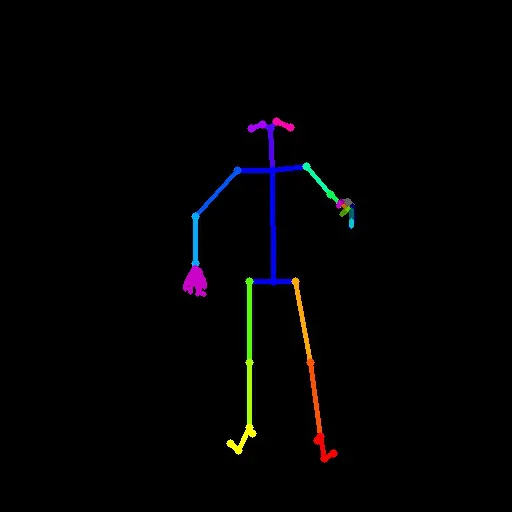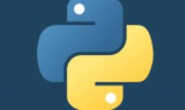环境
- windows 10 64 bit
- opencv 4.5.3
需求
这是来自一位网友的需求,他已经拿到了团队内其它成员通过 openpose 处理后的 json 数据(这部分内容前文 windows编译openpose及在python中调用 已经讲过),现在要将 json 里描述的骨骼信息描绘出来,也就是画出骨骼图。
解决步骤
要实现这个目标,首先要把 json 文件中的数据结构弄清楚。下图是拿到的 json
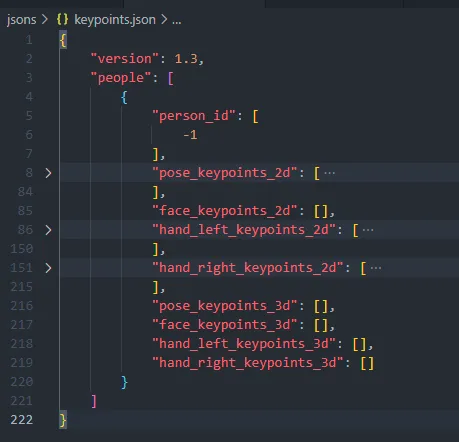
由于是 2d 的识别,所有 json 中只有字段 pose_keypoints_2d、hand_left_keypoints_2d 和 hand_right_keypoints_2d 有数据。其它情况,处理也是类似的
这里分2块来处理,身体部分与左右手的部分,前者的关键点如下图,共25个关键点
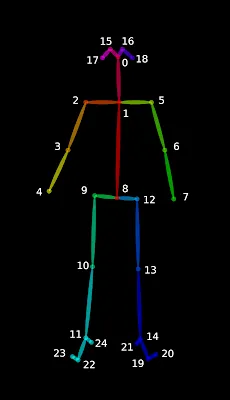
取到每一个点的位置,然后将需要连接的点进行连接,比如关键点0就需要和关键点1、15、16进行连接
pose_pairs = [
[0, 1], [0, 15], [0, 16],
[15, 17],
[16, 18],
[1, 2], [1, 5], [1, 8],
[2, 3],
[3, 4],
[5, 6],
[6, 7],
[8, 9], [8, 12],
[9, 10],
[10, 11],
[11, 22], [11, 24],
[22, 23],
[12, 13],
[13, 14],
[14, 21], [14, 19],
[19, 20]
]至于左右手的关键点也是一样,其分布如下
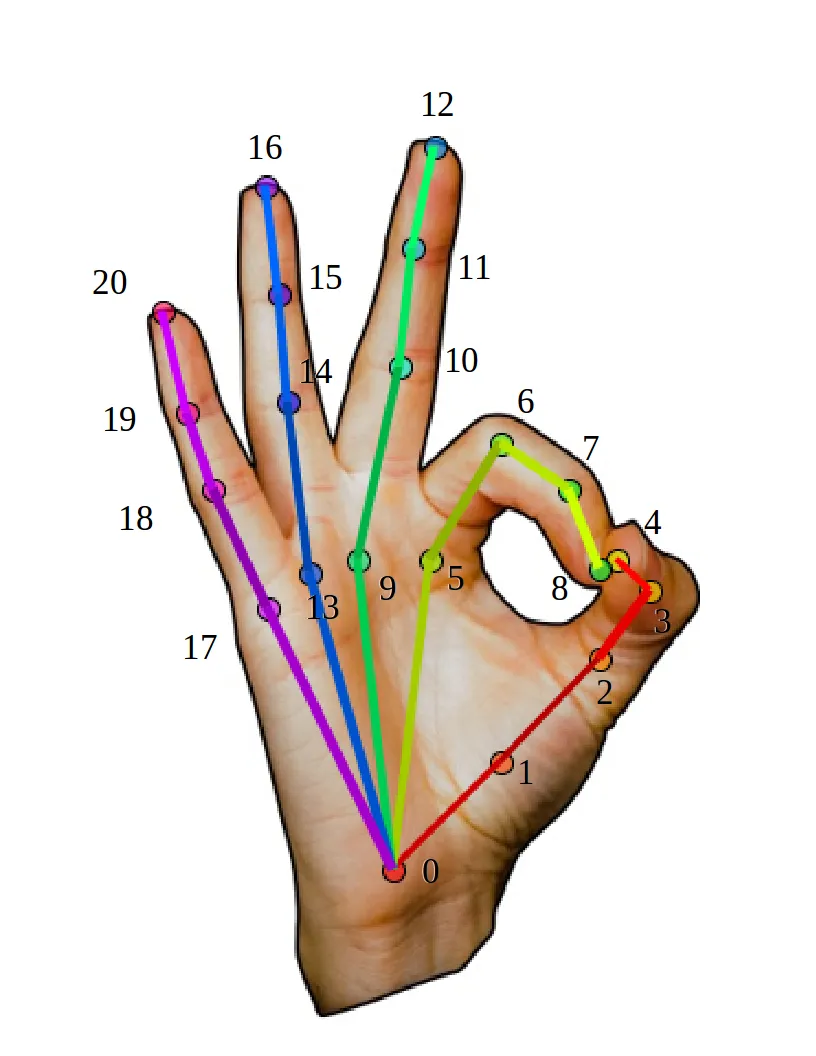
至于各个关键点的坐标,再回过头去看 json 文件,在字段 pose_keypoints_2d 中,每3个数值代表一个关键点,分别对应的是 x、y 和置信度,取到这些信息后就可以在图上标示出来了
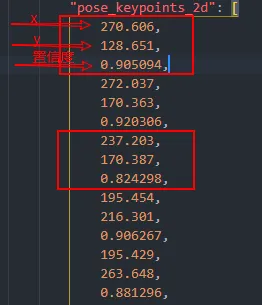
最后看一下完整的程序代码
import argparse
import json
import os
import cv2
import numpy as np
# 骨骼关键点连接对
pose_pairs = [
[0, 1], [0, 15], [0, 16],
[15, 17],
[16, 18],
[1, 2], [1, 5], [1, 8],
[2, 3],
[3, 4],
[5, 6],
[6, 7],
[8, 9], [8, 12],
[9, 10],
[10, 11],
[11, 22], [11, 24],
[22, 23],
[12, 13],
[13, 14],
[14, 21], [14, 19],
[19, 20]
]
# 手部关键点连接对
hand_pairs = [
[0, 1], [0, 5], [0, 9], [0, 13], [0, 17],
[1, 2],
[2, 3],
[3, 4],
[5, 6], [6, 7], [7, 8],
[9, 10], [10, 11], [11, 12],
[13, 14], [14, 15], [15, 16],
[17, 18], [18, 19], [19, 20]
]
# 绘制用的颜色
pose_colors = [
(255., 0., 85.), (255., 0., 0.), (255., 85., 0.), (255., 170., 0.),
(255., 255., 0.), (170., 255., 0.), (85., 255., 0.), (0., 255., 0.),
(255., 0., 0.), (0., 255., 85.), (0., 255., 170.), (0., 255., 255.),
(0., 170., 255.), (0., 85., 255.), (0., 0., 255.), (255., 0., 170.),
(170., 0., 255.), (255., 0., 255.), (85., 0., 255.), (0., 0., 255.),
(0., 0., 255.), (0., 0., 255.), (0., 255.,
255.), (0., 255., 255.), (0., 255., 255.)
]
hand_colors = [
(100., 100., 100.),
(100, 0, 0),
(150, 0, 0),
(200, 0, 0), (255, 0, 0), (100, 100, 0), (150,
150, 0), (200, 200, 0), (255, 255, 0),
(0, 100, 50), (0, 150, 75), (0, 200, 100), (0,
255, 125), (0, 50, 100), (0, 75, 150),
(0, 100, 200), (0, 125, 255), (100, 0, 100), (150, 0, 150),
(200, 0, 200), (255, 0, 255)
]
def handle_json(jsonfile):
print('hand json {}'.format(jsonfile))
with open(jsonfile, 'r') as f:
data = json.load(f)
# 纯黑色背景
img = cv2.imread('black.jpg')
for d in data['people']:
kpt = np.array(d['pose_keypoints_2d']).reshape((25, 3))
for p in pose_pairs:
pt1 = tuple(list(map(int, kpt[p[0], 0:2])))
c1 = kpt[p[0], 2]
pt2 = tuple(list(map(int, kpt[p[1], 0:2])))
c2 = kpt[p[1], 2]
print('== {}, {}, {}, {} =='.format(pt1, c1, pt2, c2))
if c1 == 0.0 or c2 == 0.0:
continue
color = tuple(list(map(int, pose_colors[p[0]])))
img = cv2.line(img, pt1, pt2, color, thickness=4)
img = cv2.circle(img, pt1, 4, color, thickness=-
1, lineType=8, shift=0)
img = cv2.circle(img, pt2, 4, color, thickness=-
1, lineType=8, shift=0)
kpt_left_hand = np.array(d['hand_left_keypoints_2d']).reshape((21, 3))
for q in hand_pairs:
pt1 = tuple(list(map(int, kpt_left_hand[q[0], 0:2])))
c1 = kpt_left_hand[p[0], 2]
pt2 = tuple(list(map(int, kpt_left_hand[q[1], 0:2])))
c2 = kpt_left_hand[q[1], 2]
# print('** {}, {}, {}, {} **'.format(pt1, c1, pt2, c2))
if c1 == 0.0 or c2 == 0.0:
continue
color = tuple(list(map(int, hand_colors[q[0]])))
img = cv2.line(img, pt1, pt2, color, thickness=4)
kpt_right_hand = np.array(
d['hand_right_keypoints_2d']).reshape((21, 3))
for k in hand_pairs:
pt1 = tuple(list(map(int, kpt_right_hand[k[0], 0:2])))
c1 = kpt_right_hand[k[0], 2]
pt2 = tuple(list(map(int, kpt_right_hand[k[1], 0:2])))
c2 = kpt_right_hand[k[1], 2]
print('** {}, {}, {}, {} **'.format(pt1, c1, pt2, c2))
if c1 == 0.0 or c2 == 0.0:
continue
color = tuple(list(map(int, hand_colors[q[0]])))
img = cv2.line(img, pt1, pt2, color, thickness=4)
if not os.path.exists('results'):
os.makedirs('results')
# 保存图片
cv2.imwrite('results/{}.jpg'.format(jsonfile.split("\\")[-1][0:-5]), img)
if __name__ == '__main__':
parser = argparse.ArgumentParser()
parser.add_argument('--directory', type=str,
default='.', help='keypoints json directory')
opt = parser.parse_args()
for jsonfile in os.listdir(opt.directory):
if jsonfile.endswith('.json'):
handle_json(os.path.join(opt.directory, jsonfile))
最后执行代码
# jsons是存放json文件的目录
python.exe main.py --directory jsons在结果文件夹 results 就会生成对应的图像了
